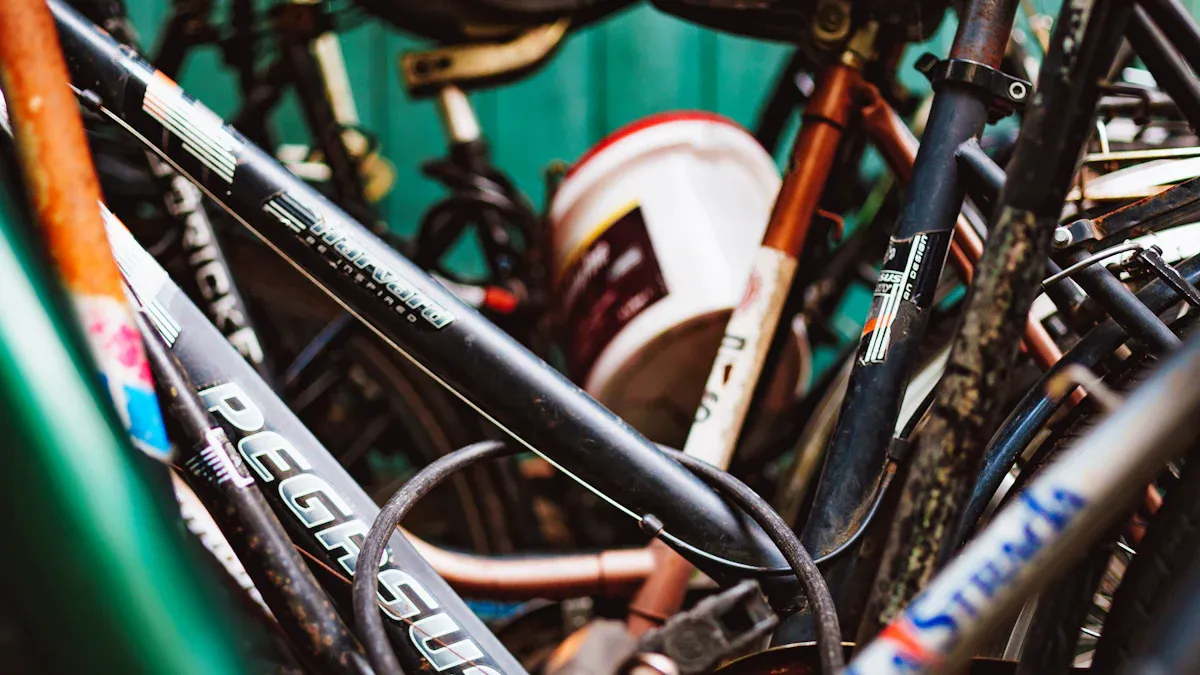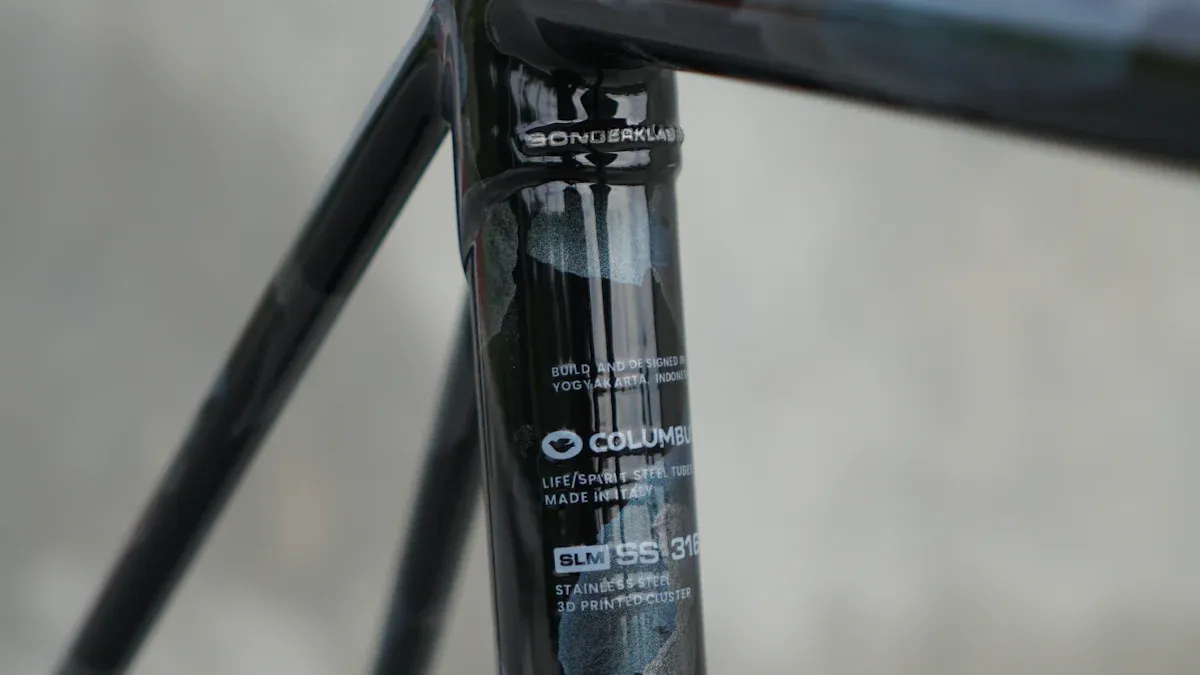
Building a bike frame can be fun. However, many people encounter problems while building bike frame projects. Knowing common mistakes helps you avoid stress and ensures your project goes smoothly. Getting ready and learning are very important steps. When you learn to build a bike, especially the building bike frame process, you gain the tools for success. This knowledge can really help you in building your bike frame.
Key Takeaways
Pick the right materials for your riding style and budget. This helps you build a safe and strong bike frame.
Measure your body and check frame angles carefully. This makes sure the bike fits well and rides smoothly.
Use the right tools and learn how to use them. This makes building easier and safer.
Focus during assembly to align parts correctly. Also, install the fork the right way.
Get ready and learn from mistakes. This helps you build a bike frame you can enjoy for years.
Material Mistakes

Wrong Material Choices
Choosing the right materials is very important when you build a bike frame. Different materials have special features that change how the bike works, its weight, and how long it lasts. Here are some common materials used in framebuilding:
Steel: It is strong and lasts a long time. It gives a smooth ride but can be heavier than other choices.
Aluminum: It is light and does not rust. It is stiff but might not absorb bumps as well as steel.
Carbon Fiber: It is super light and strong. It can be shaped in many ways but can cost a lot and may break easily in crashes.
Titanium: It has the best parts of steel and aluminum. It is light, strong, and gives a comfy ride, but it is more expensive.
When you pick materials, think about how you ride and your budget. Using the wrong material can make a bike that does not work well or is unsafe.
Ignoring Defects
Another common mistake is ignoring problems in your materials. Even small issues can cause big problems later. For example, a tiny crack in a frame can get worse with pressure and break while riding. Always check your materials closely before you start building.
Tip: Look for problems like dents, cracks, or rust. If you see any defects, do not use that material. It is better to spend money on good materials than to risk your safety.
Geometry Errors
Geometry is very important for how a bike works and how comfortable it is to ride. When you build a bike frame, the geometry affects how the bike handles and fits you. If you make mistakes with sizes or angles, your bike might feel strange or unsafe. Here are some common mistakes related to geometry.
Frame Sizing Issues
Choosing the right frame size is key for comfort. If the frame is too small, you will feel squeezed. If it’s too big, you may find it hard to control the bike. Here are some tips to avoid sizing problems:
Measure Your Height: First, measure your height. This helps you pick the right frame size.
Inseam Measurement: Also measure your inseam. This helps find the standover height of the bike.
Consult Sizing Charts: Check sizing charts from manufacturers. These charts link your measurements to the right frame size.
Tip: Always try riding a bike if you can. This shows how the frame size affects your comfort and control.
Miscalculated Angles
Angles in bike frame geometry change how the bike handles. Important angles include the head tube angle and seat tube angle. If you get these angles wrong, your bike might feel wobbly or hard to steer. Here are some mistakes to avoid:
Head Tube Angle: A steeper head tube angle makes the bike more quick but can feel twitchy. A slacker angle gives stability but may feel slow.
Seat Tube Angle: This angle affects how you pedal. A steep angle helps with climbing, while a slack angle is better for going downhill.
Tip: Use a protractor or angle finder to check your angles. Always double-check your math before cutting or welding.
By focusing on frame sizing and angles, you can avoid common geometry mistakes. Paying attention to these details will give you a better ride and a successful bike frame project.
Tool Challenges
Inappropriate Tools
When you want to build a bike, having the right tools is very important. Special tools make building easier and faster. Here are some tools you might need:
Frame Alignment Tool: This tool checks if your frame is straight.
Tube Cutter: Use this to cut tubes without hurting them.
Welding Equipment: If you use metal, good welding tools are needed for strong joints.
Torque Wrench: This tool makes sure you tighten bolts correctly.
Using the wrong tools can cause problems. For example, using a regular wrench instead of a torque wrench can over-tighten bolts. This can break parts or even cause accidents. Always buy the right tools for your project.
Tool Usage Skills
Knowing how to use your tools is just as important as having them. How well you know your tools affects how well you build. Here are some skills you should learn:
Practice Using Tools: Spend time getting used to each tool. This helps you work faster and better.
Follow Instructions: Always read the manuals or guides that come with your tools. They give helpful tips on how to use them right.
Ask for Help: If you’re not sure how to use a tool, ask someone who knows more. Learning from others can save you time and trouble.
Tip: Think about taking a workshop on bike framebuilding. This can give you hands-on practice with the tools and skills you need.
By solving tool challenges, you can make your bike frame building better. Good tools and skills lead to better results and a safer ride.
Assembly Errors

Fork Installation Mistakes
When you build a bike, putting the fork on correctly is very important. If the fork is not installed right, it can cause safety problems. Here are some mistakes to avoid:
Incorrect Orientation: Make sure the fork is facing the right way. If you put it on backward, the bike will not handle well.
Loose Bolts: Always check that the bolts are tight. Loose bolts can make the fork come off while riding, which can cause accidents.
Wrong Size: Make sure you use the right size for the fork steerer tube. Using the wrong size can make the bike unstable.
Tip: Double-check your work. Take a moment to look at the fork installation before you go to the next step.
Poor Alignment
Alignment is very important for how your bike works. If things are not aligned, it can cause uneven tire wear and affect how the bike handles. Here are some key points to think about:
Frame Alignment: Use a frame alignment tool to see if your bike frame is straight. A frame that is not aligned can cause steering problems.
Wheel Alignment: Make sure both wheels are lined up with the frame. Wheels that are not aligned can make the ride wobbly.
Brake Alignment: Check that your brakes line up with the rims. Bad brake alignment can make it harder to stop.
Tip: Take your time with alignment. Proper alignment makes for a smoother ride and keeps you safe.
By avoiding these assembly errors, you can build a bike that is safe and fun to ride. Remember, paying attention to details during assembly can really help your bike’s performance.
Making a bike frame can be fun. But, you need to avoid common mistakes. Keep these important points in mind:
Pick the right materials.
Use the right tools.
Make sure everything is put together correctly.
Being aware and getting ready are key for success. Start your bike frame project with confidence. See mistakes as chances to learn. With practice, you will get better and build a bike you can enjoy for many years! 🚴♂️
FAQ
What is the best material for a bike frame?
The best material depends on what you need. Steel is strong and comfy. Aluminum is light and stiff. Carbon fiber is super light but costs a lot. Titanium has the best parts of steel and aluminum but is pricier.
How do I measure my bike frame size?
To find your bike frame size, check your height and inseam. Use sizing charts from makers to find the right fit. Always try riding a bike to see how it feels before deciding.
What tools do I need for bike frame building?
Important tools are a frame alignment tool, tube cutter, welding gear, and a torque wrench. These tools help make sure everything is accurate and safe while building.
How can I avoid assembly errors?
Check all parts during assembly. Make sure the frame, wheels, and brakes are aligned correctly. Take your time and follow instructions closely to avoid mistakes.
Is it necessary to take a workshop for bike frame building?
While not required, a workshop can give you hands-on practice and useful skills. Learning from experts can help you avoid common mistakes and improve your building skills.
See Also
Important Advice For Anyone Building A Gas Bike Frame
Must-Have Tools And Supplies To Construct Your Bike Frame
Experiencing The Ups And Downs Of Crafting Wooden Frames
